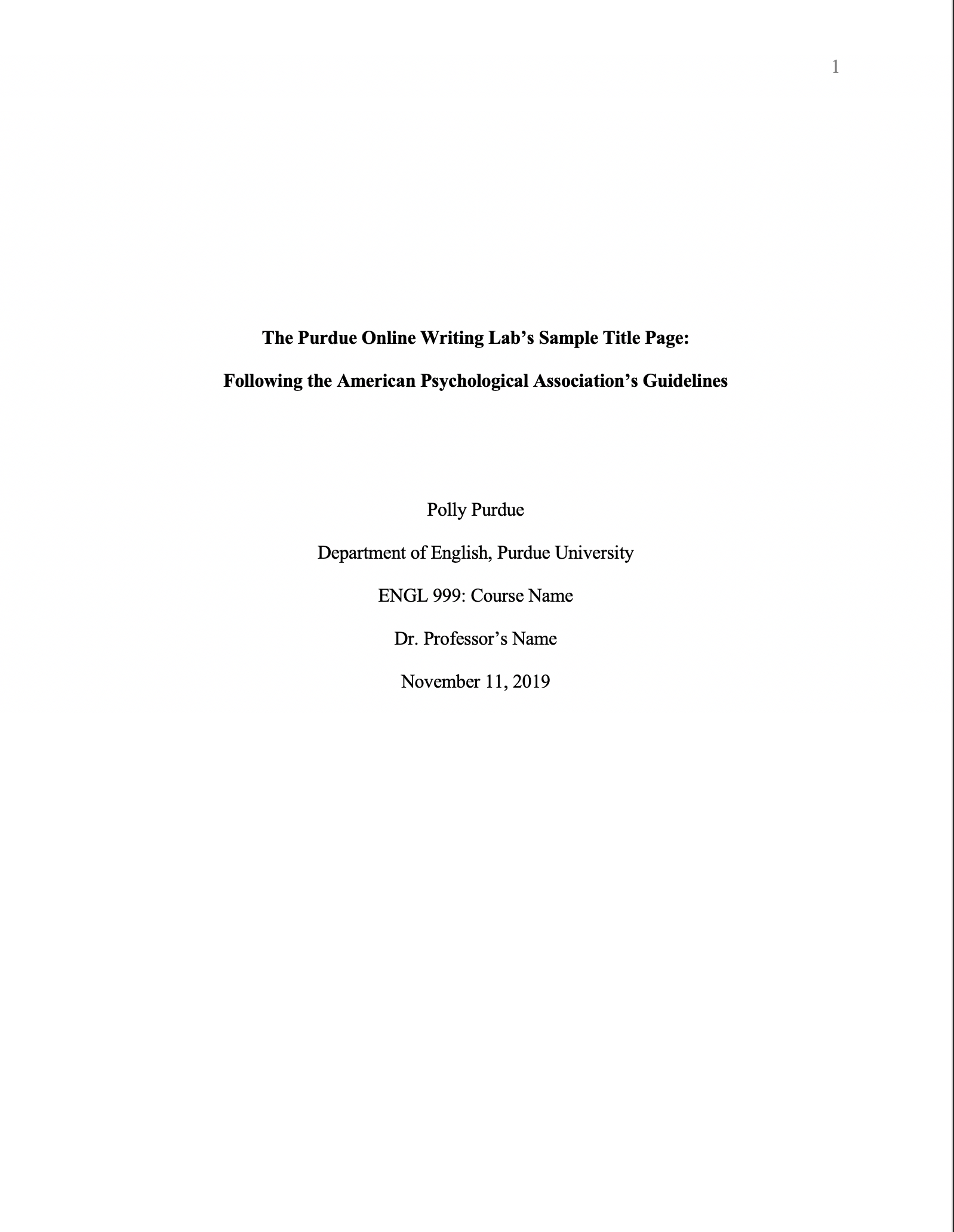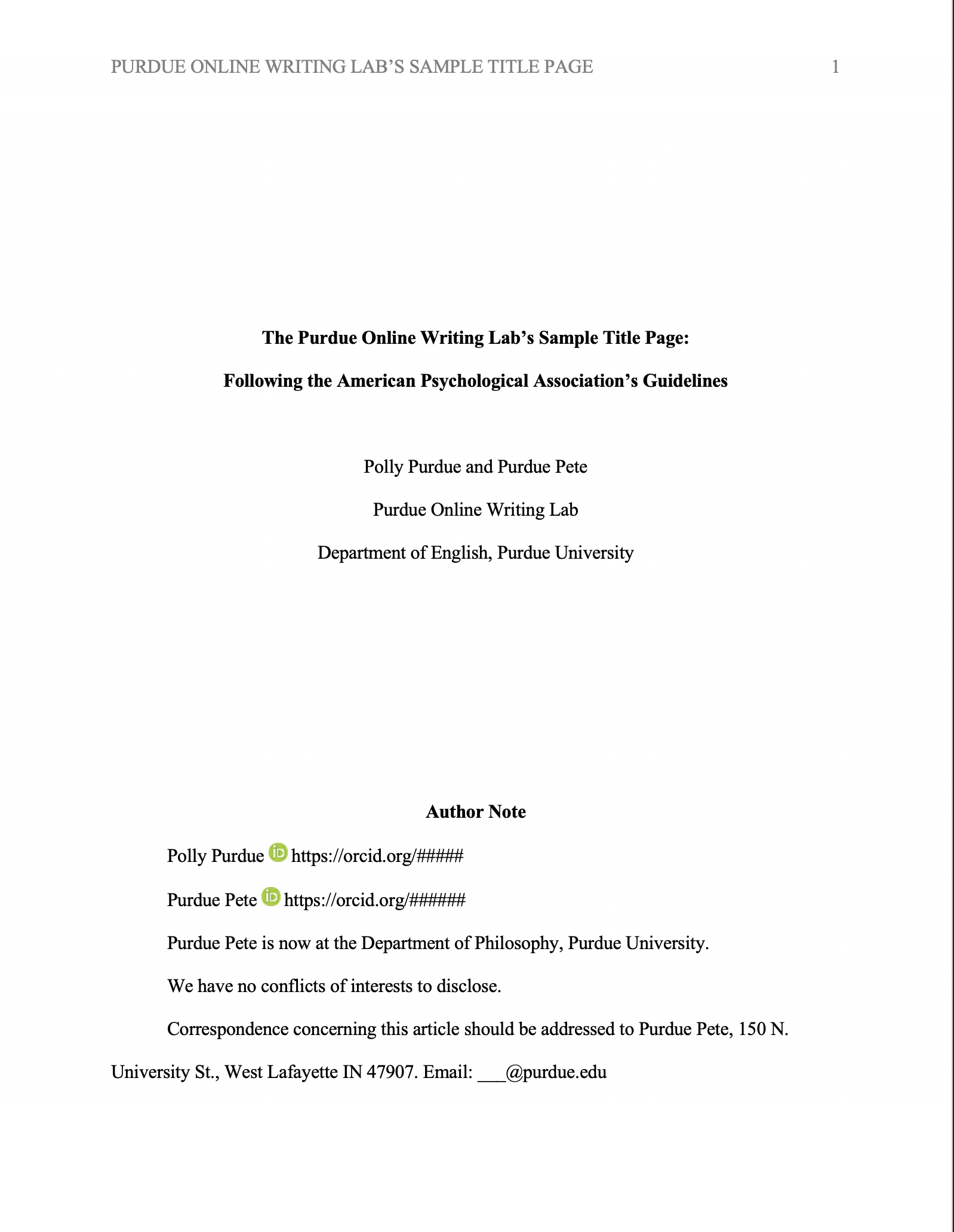General Format

Welcome to the Purdue OWL
This page is brought to you by the OWL at Purdue University. When printing this page, you must include the entire legal notice.
Copyright ©1995-2018 by The Writing Lab & The OWL at Purdue and Purdue University. All rights reserved. This material may not be published, reproduced, broadcast, rewritten, or redistributed without permission. Use of this site constitutes acceptance of our terms and conditions of fair use.
Please use the example at the bottom of this page to cite the Purdue OWL in APA.
You can also watch our APA vidcast series on the Purdue OWL YouTube Channel.
General APA Guidelines
Your essay should be typed and double-spaced on standard-sized paper (8.5" x 11"), with 1" margins on all sides. Include a page header (also known as the “running head”) at the top of every page. For a professional paper, this includes your paper title and the page number. For a student paper, this only includes the page number. To create a page header/running head, insert page numbers flush right. Then type "TITLE OF YOUR PAPER" in the header flush left using all capital letters. The running head is a shortened version of your paper's title and cannot exceed 50 characters including spacing and punctuation.
Font
The 7th edition of the APA Publication Manual requires that the chosen font be accessible (i.e., legible) to all readers and that it be used consistently throughout the paper. It acknowledges that many font choices are legitimate, and it advises writers to check with their publishers, instructors, or institutions for guidance in cases of uncertainty.
While the APA Manual does not specify a single font or set of fonts for professional writing, it does recommend a few fonts that are widely available. These include sans serif fonts such as 11-point Calibri, 11-point Arial, and 10-point Lucida Sans Unicode as well as serif fonts such as 12-point Times New Roman, 11-point Georgia, 10-point Computer Modern.
Major Paper Sections
Your essay should include four major sections: the Title Page, Abstract, Main Body, and References.
Title Page
Note: APA 7 provides slightly different directions for formatting the title pages of professional papers (e.g., those intended for scholarly publication) and student papers (e.g., those turned in for credit in a high school or college course).
The title page should contain the title of the paper, the author's name, and the institutional affiliation. A professional paper should also include the author note. A student paper should also include the course number and name, instructor name, and assignment due date.
Type your title in upper and lowercase letters centered in the upper half of the page. The title should be centered and written in boldface. APA recommends that your title be focused and succinct and that it should not contain abbreviations or words that serve no purpose. Your title may take up one or two lines. All text on the title page, and throughout your paper, should be double-spaced.
Beneath the title, type the author's name: first name, middle initial(s), and last name. Do not use titles (Dr.) or degrees (PhD).
Beneath the author's name, type the institutional affiliation, which should indicate the location where the author(s) conducted the research.
A professional paper should include the author note beneath the institutional affiliation, in the bottom half of the title page. This should be divided up into several paragraphs, with any paragraphs that are not relevant omitted. The first paragraph should include the author’s name, the symbol for the ORCID iD, and the URL for the ORCID iD. Any authors who do not have an ORCID iD should be omitted. The second paragraph should show any change in affiliation or any deaths of the authors. The third paragraph should include any disclosures or acknowledgements, such as study registration, open practices and data sharing, disclosure of related reports and conflicts of interest, and acknowledgement of financial support and other assistance. The fourth paragraph should include contact information for the corresponding author.
A student paper should not include an author note.
Note again that page headers/page numbers (described above for professional and student papers) also appear at the top of the title page. In other words, a professional paper's title page will include the title of the paper flush left in all capitals and the page number flush right, while a student paper will only contain the page number flush right.
Student APA title page

Title page for a student paper in APA 7 style.
Professional paper APA title page

Title page for a professional paper in APA 7 style.
Abstract
Begin a new page. Your abstract page should already include the page header (described above). On the first line of the abstract page, center and bold the word “Abstract” (no italics, underlining, or quotation marks).
Beginning with the next line, write a concise summary of the key points of your research. (Do not indent.) Your abstract should contain at least your research topic, research questions, participants, methods, results, data analysis, and conclusions. You may also include possible implications of your research and future work you see connected with your findings. Your abstract should be a single paragraph, double-spaced. Your abstract should typically be no more than 250 words.
You may also want to list keywords from your paper in your abstract. To do this, indent as you would if you were starting a new paragraph, type Keywords: (italicized), and then list your keywords. Listing your keywords will help researchers find your work in databases.
Abstracts are common in scholarly journal articles and are not typically required for student papers unless advised by an instructor. If you are unsure whether or not your work requires an abstract, consult your instructor for further guidance.
APA Abstract Page

Abstract page for a student paper in APA 7 style.
Please see our Sample APA Paper resource to see an example of an APA paper. You may also visit our Additional Resources page for more examples of APA papers.
How to Cite the Purdue OWL in APA
Individual Resources
The page template for the new OWL site does not include contributors' names or the page's last edited date. However, select pages still include this information.
In the absence of contributor/edit date information, treat the page as a source with a group author and use the abbreviation "n.d." for "no date":
Purdue Online Writing Lab. (n.d.). Title of resource. Purdue Online Writing Lab. http://Web address for OWL resource
Purdue Online Writing Lab. (n.d.). General Writing FAQs. Purdue Online Writing Lab. https://owl.purdue.edu/owl/general_writing/general_writing_faqs.html
The generic APA citation for OWL pages, which includes author/edit date information, is this:
Contributors' names. (Last edited date). Title of resource. Site Name. http://Web address for OWL resource
Note: This page reflects the latest version of the APA Publication Manual (i.e., APA 7), which released in October 2019. The equivalent resource for the older APA 6 style can be found here.